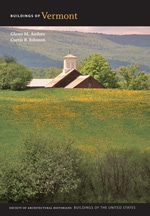
Hart H. Winchester built this small tenant house as a leasable property. The wood-frame, one-and-a-half-story house, with an attached kitchen and working wing, and an expanded English barn, illustrates several vernacular trends in the remote upper Deerfield River Valley in the mid-nineteenth century. First, it exemplifies the connected architecture scheme frequently used to organize farmyards in eastern Vermont. Second, it epitomizes the half Classic Cottage, the eaves-front, side-hall type common to modest upland farms. Third, it typifies the deep open eaves (as opposed to boxed eaves) and a steep roof pitch that developed in many of the heavy snow regions of the Green Mountains. Finally, its classical details, particularly its entrance pilasters, are narrow and applied in a manner that is more Federal than the Greek Revival expected by its date. Winchester farmed two hundred and seventy acres, had seven hundred sugar trees and nine Durham cattle, and lived in the Classic Cottage farmhouse across the road from this tenant house. His son, Carley C. Winchester, later occupied the dwelling and was probably responsible for enlarging the English barn and adding another barn in the last decades of the nineteenth century. Milo Lyman, who moved to the area as an engineer on the Harriman reservoir and dam project, purchased the house and the land in 1926 and ran it as a dairy farm. His descendants still occupy the homestead and have adapted the barns to a nursery business.














